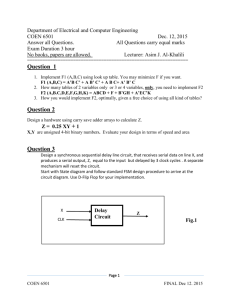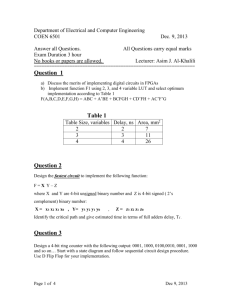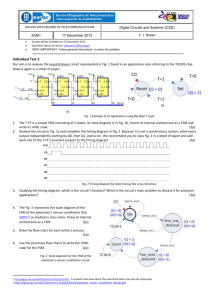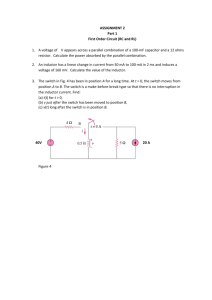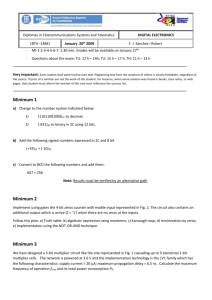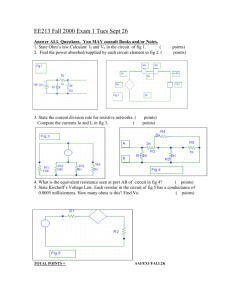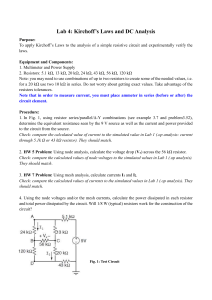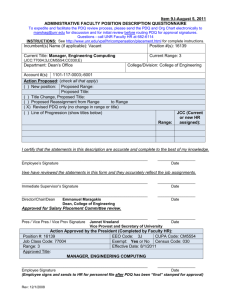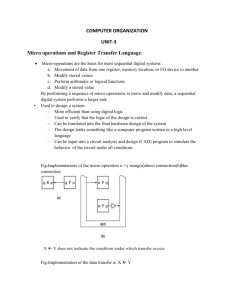6501_Dec_2014
advertisement
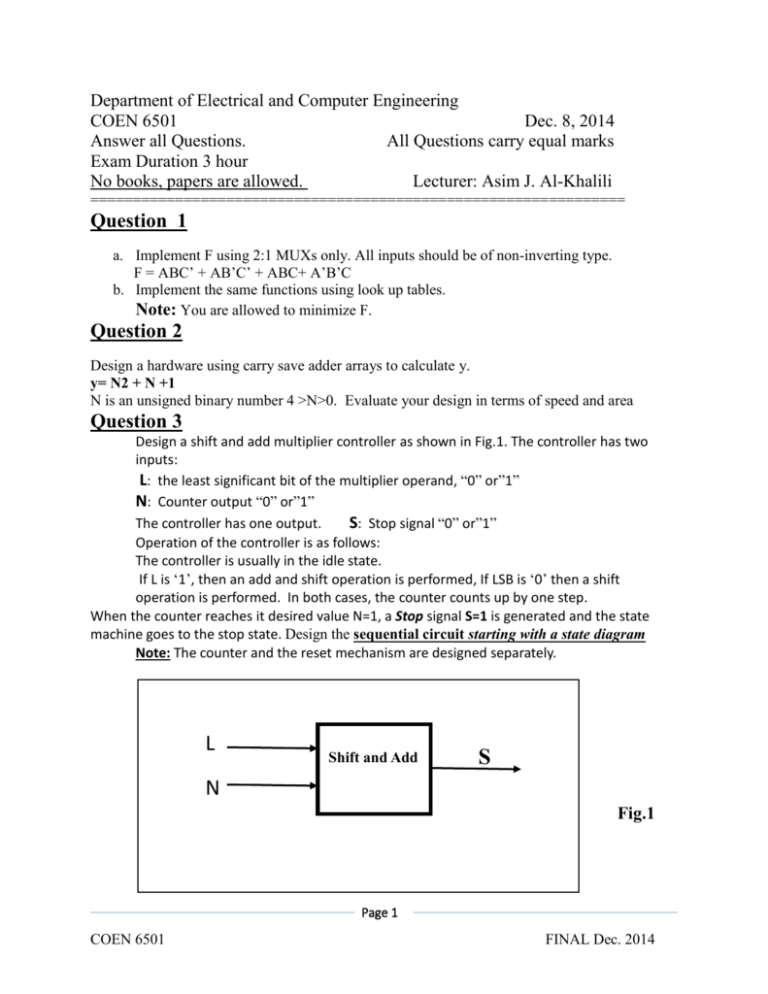
Department of Electrical and Computer Engineering COEN 6501 Dec. 8, 2014 Answer all Questions. All Questions carry equal marks Exam Duration 3 hour No books, papers are allowed. Lecturer: Asim J. Al-Khalili =============================================================== Question 1 a. Implement F using 2:1 MUXs only. All inputs should be of non-inverting type. F = ABC’ + AB’C’ + ABC+ A’B’C b. Implement the same functions using look up tables. Note: You are allowed to minimize F. Question 2 Design a hardware using carry save adder arrays to calculate y. y= N2 + N +1 N is an unsigned binary number 4 >N>0. Evaluate your design in terms of speed and area Question 3 Design a shift and add multiplier controller as shown in Fig.1. The controller has two inputs: L: the least significant bit of the multiplier operand, “0” or”1” N: Counter output “0” or”1” The controller has one output. S: Stop signal “0” or”1” Operation of the controller is as follows: The controller is usually in the idle state. If L is ‘1’, then an add and shift operation is performed, If LSB is ‘0’ then a shift operation is performed. In both cases, the counter counts up by one step. When the counter reaches it desired value N=1, a Stop signal S=1 is generated and the state machine goes to the stop state. Design the sequential circuit starting with a state diagram Note: The counter and the reset mechanism are designed separately. L Shift and Add S N Fig.1 Page 1 COEN 6501 FINAL Dec. 2014 Question 4 a. Identify all the paths in the circuit shown in the Fig. 2 below. b. Determine maximum speed of operation at typical conditions for the Timing parameters for all components are listed in Table 1. c. At the maximum speed of operation, determine the slack time for the setup time and hold time at the D-input of Flip-Flop U2. U4 U5 Z U7 D U1 D U6 Q U2 U8 U3 U10 Q D Q U11 U9 CLK Fig. 2 Component Tp (ns) Input Loading (UL) K1 K2 ns/fanout ns/UL Inverter 0.15 1 0.1 0.08 NAND/NOR(2input) 0.24 2 0.05 0.14 NAND (3 input) 0.4 1.5 0.12 0.18 Flip Flop, ↑, (CK to Q) 1.5 2 0.1 0.2 Tsu=1 ns, th = 0.5ns Table 1 Page 2 COEN 6501 FINAL Dec. 2014 Question 5 a. The Circuit shown in Fig. 2 operates at a frequency 50 MHz. Signal A arrives at -∞. Determine the arrival time, the required time and the slack time at points B and C. b. Determine the maximum clock frequency, considering worst case scenario. The circuit is implemented on a die, packaged in a ceramic DIP with a thermal resistance of 30oC/W. Power consumption of the chip is 1.5 W with room temp at 25C. Fanout loading is neglected. Use Table 2 parameters. c. Determine the maximum frequency of operation if skew is −2ns. 0.4ns D1 B Q U3 CLK 0.2ns C U1 D2 D2 A Q D3 Q 0.3ns Q Q U2 CLKd CLK Fig. 2 (Tp K1 Ni K 2 ML) * K ' , TJ = Tamb + Φ Ja * PdKV = 1 1 0.01 * fV Component T2 KT = 1.5 , T1 K’ = KT * KV *K , KP = 1+ 0.01 * fP Tp (ns) Input Loading (UL) K1 AND/(2input) 0.2 1 0.15 OR (2 input) 0.3 2 0.25 XOR (3 input) 0.4 3 0.35 Flip Flop, ↑, (CLK to Q) 2 4 0.45 ns/UL Table 2 Tsu=1 ns, th = 0.5ns , tskew=2ns Page 3 COEN 6501 FINAL Dec. 2014 Question 6 For the circuit shown below, a) Write a structural VHDL code for the entity “Adder”. b) Write behavioral VHDL code, “Test_Bench” for testing the circuit Test_Bench Generator Adder c) Draw a response to the following VHDL Code process begin B<= not A ; wait until A=‘1’ for 10 ns; end process; A 10 20 30 40 50 60 B ------------------------------------------------------------- ? ===================================================================== Appendix A 1. tcs,max < tCQmin + tCLmin + tsu.min 2. Tmin tCQmax + tCLmax+ tsUmaxR2 –tcsmin 3. thmaxR2 < tCQmin + tCLmin - tcsmax tCL = tLogic + tinterconnec Page 4 COEN 6501 FINAL Dec. 2014
